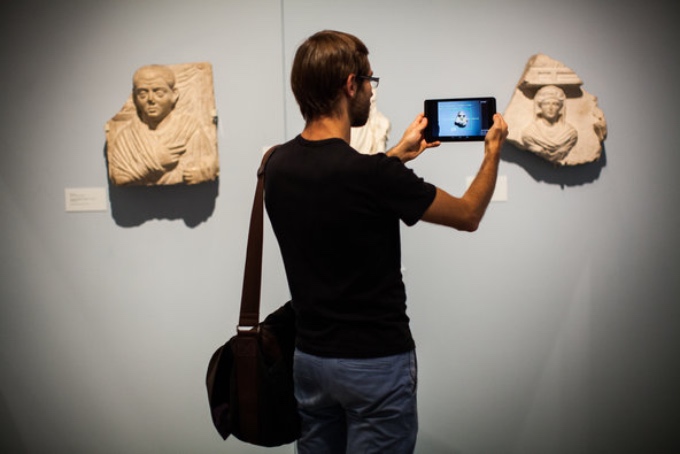Imagining how #hexology could enrich museums and theme parks opens up a mind-fest of possibilities and ideas, so many stories to tell and so many different ways to tell them. What if they had the power to write those stories into space and places for visitors to discover?
The discovery experience may start with an advert in a magazine, a brochure in the tourist information office or with a poster in the street. Once inside the attraction, information is layered, buildings are divided into sections and narratives broken into themes; within themes there are chapters and then micro-stories for every exhibit on display.
Imagine augmenting this experience digitally, using a platform that makes it as easy to write a story into an object, space or place, as it is to update your favourite social networking site. The magazines, brochures and posters are now connected and enriched with digital content; the entrances, sections, chapters and exhibits enhanced with digital stories!
Creating this digital experience would require a platform that gives control over the many different levels of information. From top level stories that introduce a theme to the lower level micro-stories, different technologies are needed to deliver different kinds of information with different levels of granularity; and this is where #hexology steps in.
#hexology combines proximity and location based tagging technologies into one powerful environment that is flexible and easy to use. That’s why we get so excited about the museum and theme park opportunity, the user scenarios would test and stretch every aspect of our technology portfolio – it’s our Mount Everest – the very pinnacle of what #hexology can do.

To distinguish the opportunity hexology has created, consider the following.
- The #hexology app is free!!!
- Curators can use the #hexology app to publish digital content in a space or a place.
- Visitors can use the #hexology app to discover the digital content the curators have published.
- Curators would not need to engage a software development specialist to fit an expensive bespoke installation.
- Visitors can use their smartphones, keep the information they discover and relive their experience when they get home.
- Published information is easy to update, new content gets sent automatically to anyone who has picked up the source.
Suddenly, a community has formed around an exhibit and people can use the stream to add their voice too, now it’s a conversation! We’ve added moderator controls which includes turning off the option to allow others to add feedback, so it’s in your control and discretion to use.
So how can I use #hexology app to get started? Starting from high level to low-level here are some thoughts>
- GPS – Location aware (cannot be moved) – internet dependent
Writing information into a GPS location allows curators to publish information about their exhibits outside of a Museum, imagine adding an article to a historic site. Visitors to the site would then pick up the article when they walk into the region of those GPS co-ordinates and the story would reveal additional information that would led them (via maps) to another location. The good thing about GPS is that you don’t need to create anything such as a QR code or an NFC tag. The down-side of GPS is that it is not very accurate and performs badly indoors, so you couldn’t use GPS to share content about a small exhibit that is sharing a display case with many other exhibits.
- #hex – Proximity Beacon – no internet needed
Write a message into #hex and broadcast it to anyone that walks in to proximity, without the use of an internet connection. With a radius of 25m, #hex creates the possibility to share something special with a visitor in a certain part of the building. Putting a #hex at the entrance could send a welcome message along with an introduction, or some directions.
- QR Codes – Easy to use
Using the #hexology app to generate a QR code and then write a story into it is a simple way to get information into a specific location. Visitors are then able to pick up the story by scanning the QR code with the #hexology app, placing QR codes next to an exhibit helps the visitor understand that the content relates to a particular exhibit. The good thing about the #hexology app is that the QR codes are automatically generated when you create your story content and then you can use the QR code in any printed material, this way people can scan content that has been circulated through a local newspaper or magazine. QR codes are free to create and easy to distribute.
- NFC – Easy to hide
Contactless smart-cards and stickers are easy to hide, they can be woven into the bindings of a book for example. Buy an object in the shop, take it home and no-one would know that there is a digital story inside. NFC stickers vary in price and at present only the Android version of the #hexology app is able to read and write information into an NFC tag, even though NFC reader is now in the latest iPhone (6 & 6s) Apple doesn’t allow developers (like us) to access it.
Embedding audio via Soundcloud and Video via youtube, empowers curators and designers with an ability to enrich all of the spaces and places they create with multimedia content.
#hexology has created an ability to write stories into objects, spaces and places through its free app and low-cost bluetooth beacon. Combined, the #hex beacon and the free #hexology app gives Curators and theme park designers an easy to use, powerful and flexible environment to spread digital magic around the world for others to discover.






